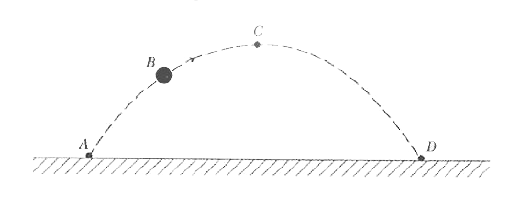A small ball is given some velocity at point A towards right so that it moves on the semicircular track and does not leave contact up to the highest point B. After leaving the highest point B, it falls at the top of a building of height R and width x(x<<2R). (All the surfaces are frictionless).

The velocity given to the ball at point A so that it may hit the top of the building is
(a) √4gR
(b) √2gR
(c) √gR
(d) √6gR
The correct Answer is:D
Let t be the time taken by the ball from B to C.
R=12gt2
t=√2Rg
2R=v√2Rg
v=√2gR
Applying energy conservation at point A and B,
12mv20=12mv2+mg2R
⇒v0=√6gR
Topper's Solved these Questions
- WORK, POWER & ENERGYBOOK - CENGAGE PHYSICSCHAPTER - WORK, POWER & ENERGYEXERCISE - Integer
14 Videos
- WORK, POWER & ENERGYBOOK - CENGAGE PHYSICSCHAPTER - WORK, POWER & ENERGYEXERCISE - Archives (sinble Correct )
19 Videos
- WORK, POWER & ENERGYBOOK - CENGAGE PHYSICSCHAPTER - WORK, POWER & ENERGYEXERCISE - Multiple Correct
25 Videos
- VECTORSBOOK - CENGAGE PHYSICSCHAPTER - VECTORSEXERCISE - Exercise Multiple Correct
5 Videos
Similar Questions
Knowledge Check
A small ball is given some velocity at point A towards right so that it moves on the semicircular track and does not leave contact up to the highest point B. After leaving the highest point B, it falls at the top of a building of height R and width x(x<<2R). (All the surfaces are frictionless).

The horizontal distance of the ball from the foot of the builing where the ball strikes the horizontal ground willA(a) √2RB(b) (1+√2)RC(c) 2(1+√2)RD(d) 12RA small ball is given some velocity at point A towards right so that it moves on the semicircular track and does not leave contact up to the highest point B. After leaving the highest point B, it falls at the top of a building of height R and width x(x<<2R). (All the surfaces are frictionless).

If the collision of ball with the building is elastic, then the angle with the horizontal at which the ball will rebound from the top of the building isA(a) 60∘B(b) 45∘C(c) 30∘D(d) NoneA ball is thrown upwards from a point A.It reechec up to the highest point B and returns.
AKinetic energy at A= kinetic energy at BBPotential energy at A= potential energy at BCPotential energy at B= kinetic energy at BDPotential energy at B= kinetic energy at A
The projectile has only vertical component of velocity at the highest point of its trajectory.
At the highest point, only one component of velocity is present.
View SolutionA tennis ball is thrown upward at an angle from point A. It follows a parabolic trajectory and hits the ground at point D. At the instant shown, the ball is at point B. Point C represents the highest position of the ball above the ground.

While in flight, how do the x and y components of the velocity vector of the ball compare at the points A and D?
View SolutionA fighter plane is moving in a vertical circle of radius 'r'. Its minimum velocity at the highest point of the circle will be
View SolutionA tennis ball is thrown upward at an angle from point A. It follows a parabolic trajectory and hits the ground at point D. At the instant shown, the ball is at point B. Point C represents the highest position of the ball above the ground.

While in flight, how do the x and y components of the velocity vector of the ball compare at the points B and C?
View SolutionThe maximum velocity at the lowest point, so that the string just slack at the highest point in a vertical circle of radius l.
View Solution
